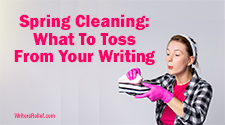
As writers, we’re always eager to add more skills to our writing bag of tricks—and two of the trickiest-sounding literary devices are parataxis and hypotaxis. While they may seem like a pair of magic spells used by your favorite wizard or the main characters in an ancient Greek comedy, parataxis and hypotaxis are writing styles that can enhance your poetry, short story, novel, or memoir. The style and grammar experts here at Writer’s Relief have put together a few tips on how to use parataxis and hypotaxis correctly when writing.
How To Use Parataxis and Hypotaxis
Parataxis is a writing style that places clauses one after another, without connecting words (conjunctions) to show the relation between them. The sentences are arranged in no particular order in this “side-by-side” style since there is no hierarchy to their importance level. Each sentence has an equal amount of weight placed on it.
Famous example of parataxis: I came, I saw, I conquered.
Not-so-famous example of parataxis: Pat made an apple pie. Apple pie is his favorite food.
No sentence or clause has any more emphasis or importance placed on it than another. In our not-so-famous example written by our hungry editor, you have been given two facts about Pat and nothing more. But we do agree with Pat. Apple pie is quite tasty.
Hypotaxis is the opposite of parataxis: It uses conjunctions and pronouns to connect a sentence’s main clause to its dependent elements. These complex sentences introduce a hierarchy of importance and show your readers the cause and effect in the sentences.
Famous example of hypotaxis: After the lions had returned to their cages, creeping angrily through the chutes, a little bunch of us drifted away and into an open doorway nearby, where we stood for a while in semi-darkness watching a big brown circus horse go harumphing around the practice ring… (“The Ring of Time” by E. B. White).
Not-so-famous example of hypotaxis: Since apple pie is his favorite food, Pat decided to bake one. Then he’ll enjoy apple pie with ice cream for dessert later tonight.
“Since” in the first sentence and the use of the subordinate clause show us that Pat decided to bake an apple pie because it is his favorite! All the other information expands on Pat’s love of apple pie. We have still learned some facts about Pat, but now we also know why these events occurred and in what order. Maybe Pat will be inspired to share his delicious apple pie dessert with a deserving editor.
Parataxis and hypotaxis both have their place in writing. However, using them correctly is key to keeping your readers engaged without confusing them.
When to use parataxis: Parataxis creates short, choppy sentences with a staccato rhythm. This style is effective when creating a stream-of-consciousness effect or during dialogue, since it can mimic the way people talk. It also works well when describing something your narrator is watching.
When to use hypotaxis: Hypotaxis is best used for establishing development in your writing. It can also be used to provide an emotional touch, or for persuasion or to argue a certain point. You should use hypotaxis when it’s not just the actions that are important but also the motivation and reasoning behind them.
Writing, like life, needs a healthy mix of simplicities and complexities to keep it interesting. Be sure to balance parataxis and hypotaxis in your writing, rather than focusing solely on one style or the other.
One thing that doesn’t need more complexity: Your submission strategy! Fortunately, making your writing submissions can be easy as pie (apple or any other flavor!): Let Writer’s Relief do the research and busywork for you. Our research experts will pinpoint the best markets for your writing. With just a few clicks your work will be sent, your odds of getting an acceptance will be boosted, and you can get back to writing. Learn more and submit your writing sample to our Review Board today!
Question: Do you tend to use more parataxis or hypotaxis in your writing?




















The grammatical structure of hypotactic sentences, on the other hand, ensures that their phrases are organized as a main clause supported by subordinate clauses.
You should use hypotaxis when it’s not just the actions that are important but also the motivation and reasoning behind them.
Thanks!
I love this. Thanks so much for sharing.
Thank you!